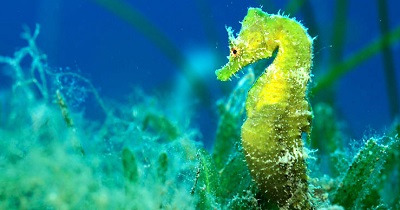The Latin name for seahorse is Hippocampus which means “Horse Caterpillar”. While seahorses appear to be very different from other fishes in the sea, they are fish nonetheless. According to the Smithsonian National Museum of National History there are 47 species of seahorses.
Taxonomy

Seahorse from Sea Life Sydney Aquarium
- Kingdom: Animalia
- Phylum: Chordata
- Class: Actinopterygii
- Order: Syngnathiformes
- Family: Syngnathidae
- Subfamily: Hippocampinae
- Genus: Hippocampus
0
Habitat and Distribution
- Seahorses live in seagrass beds, mangrove roots, and coral reefs, in shallow temperate and tropical waters around the world. Their distribution ranges approximately from 50 degrees north to 50 degrees south latitude.
- According to Seahorse Project, a conservation organization, currently there are 52 recognized species of seahorses; however this number is likely to increase with further taxonomic research.
Physical Features
- Seahorses can look in two different directions at once.
- Instead of scales, seahorses have thin skin stretched over a series of bony plates that are visible as rings around the trunk.
- Some species also have spines, bony bumps, or skin filaments protruding from these bony rings.
- A group of spines on the top of the head is called the coronet because it looks like a crown. The coronet is different in all seahorses
- While seahorses appear to be very different from other fish in the sea, they belong to the same class as all other bony fish (Actinopterygii), such as salmon or tuna.
- Seahorses are masters of camouflage, changing color and growing skin filaments to blend in with their surroundings
- Seahorses have no stomach or teeth. Instead, they suck their prey in through a tubular snout (a fused jaw) and pass it through an inefficient digestive system.
- Males have a brood pouch in their front.
Social Behavior
- Most species of seahorse studied in the wild do appear to be monogamous, remaining faithful to one partner for the duration of the breeding season and perhaps even over several seasons.
Weight and Height
- Seahorses measure from 0.6 to 14 in or 1.5 to 35cm long. Their weight varies depending on age and reproductive stage.
Diet
- Seahorses use their snouts to suck in their food.
- They eat small crustaceans and plankton. They consume more than 3,000 brine shrimp a day.
Breeding
- Male or female? The female deposits her eggs in the male’s pouch, after which the male fertilizes them. The male’s pouch acts like a womb until the eggs hatch.
- Most males give birth to around 100-200 babies. One Hippocampus reidi male gave birth to 1572 young.
- Seahorses, pipefish and seadragons are the only animals in which the male bears the unborn.
- Pregnancy lasts from 2 to 5 weeks.
Life Expectancy
- In captivity small species of seahorses live an average of one year while larger species an average of 3 to 5 years. Their life span in the wild is unknown.
Threats
- Their biggest threat is degradation of their habitat by human activities.
- Seahorses are bad swimmers and they easily die during storms.
Additional Facts
- The seahorse and the razorfish are the only fish that swim upright.
- Traditional Chinese Medicine has made use of the seahorse for about 600 years.
- Seahorses are the slowest moving fish in the world.